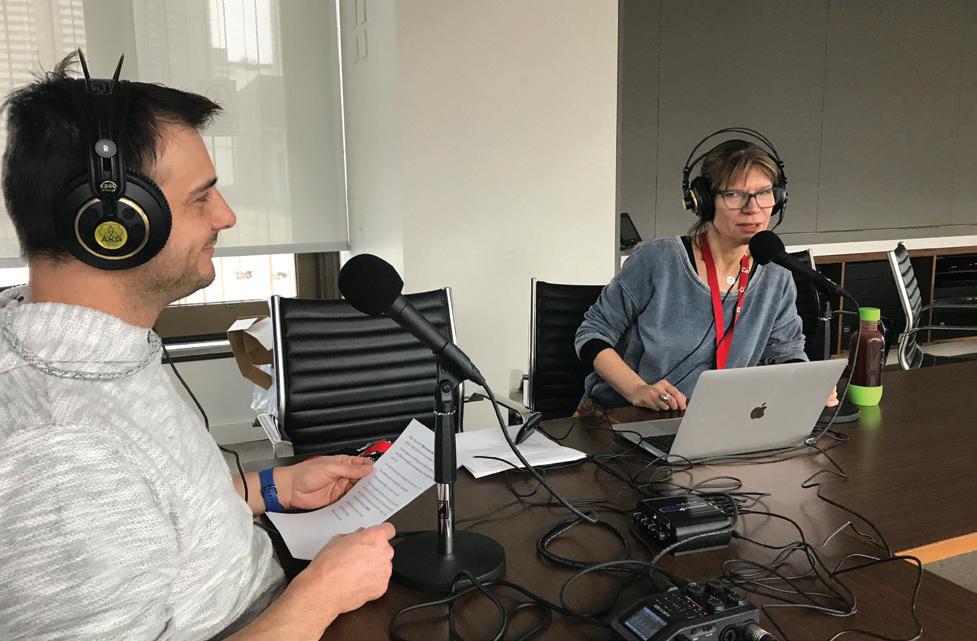
3 minute read
AMPLIFYING THE VOICES OF
POSITIVELY SPEAKING AMPLIFYING THE VOICES OF THE HIV COMMUNITY Casey House’s peer program manager talks about the podcast Positively Speaking
In December, Toronto’s Casey House launched Positively Speaking, a new podcast dedicated to sharing diverse and compelling stories that help give a voice to people living with HIV.
We recently sat down with Andre Ceranto, peer program manager at Casey House and one of the hosts of the podcast, to talk about the six-episode first season and the range of topics covered.
How does Casey House support the HIV community? Casey House is Ontario’s HIV/AIDS hospital. It opened in Toronto in 1988 and has evolved from Canada’s first stand-alone treatment facility for people living with HIV and AIDS into a hospital with primarily outpatient programming. As an HIV specialty hospital, we have an innovative and multidisciplinary approach to health and well-being.
Casey House has always led the way in offering innovative and exciting programming to support the HIV community. How does Positively Speaking fit into that programming? It gives voice to people living with HIV and AIDS by sharing their diverse and compelling stories. The podcast is a creative, accessible medium for clients to tell stories, build skills and validate their experiences while challenging stigma through the power of narrative.
How did Positively Speaking come about? What was the inspiration for this podcast? It was a staff-led initiative to engage clients and peers and bring more awareness to the realities of life with HIV/AIDS. It was inspired by Ear Hustle, which shares the experience of San Quentin prison through the voices of those incarcerated.
What are some of the topics the podcast speaks to? Why is it important to bring these themes and voices to the forefront? Clients participated both as part of an advisory group and as storytellers, sharing their experience living with HIV/AIDS. An even wider group determined topics for the six-episode first season through collaborative brainstorming sessions to identify possible themes. Each episode examines a different aspect of life with HIV as experienced by clients: HIV and long-term survivors, relationships, mental health, housing, isolation and living positively. We hope the conversations both inspire and provoke. What has the feedback from the community been about Positively Speaking? What’s in store for the future of the program? Everyone has been extremely positive about the podcast, and the listener numbers keep rising. I think people are surprised at the professional production, thanks to the RTA School of Media at Ryerson University, and my colleague, social worker Liz Creal, is getting compliments on her hosting skill. We are already at work on Season 2. The episodes in the second season will be issues-focused and will dive more deeply into each topic.
Where does this initiative fit within Casey House’s overarching strategy to provide peer-to-peer support? Casey House launched an innovative peer program to complement the work of the interdisciplinary healthcare team and further support those living with HIV/AIDS. We are committed to involving peers with the grateful support of ViiV Healthcare’s community grants program, and continue to expand our peer programming with projects like Positively Speaking. It is important to provide different opportunities for meaningful engagement that meet the interest and comfort level of the participants.
Beyond your avid listeners, what is the impact of a program like this? In addition to being committed to providing judgment-free health care, Casey House is passionate about amplifying our clients’ voices. We do this by advocating for individual clients, by increasing awareness of HIV and its complexities with our #smashstigma awareness campaign, and now with the podcast. Listen to Positively Speaking at caseyhouse.com or wherever you find podcasts, and then subscribe.









